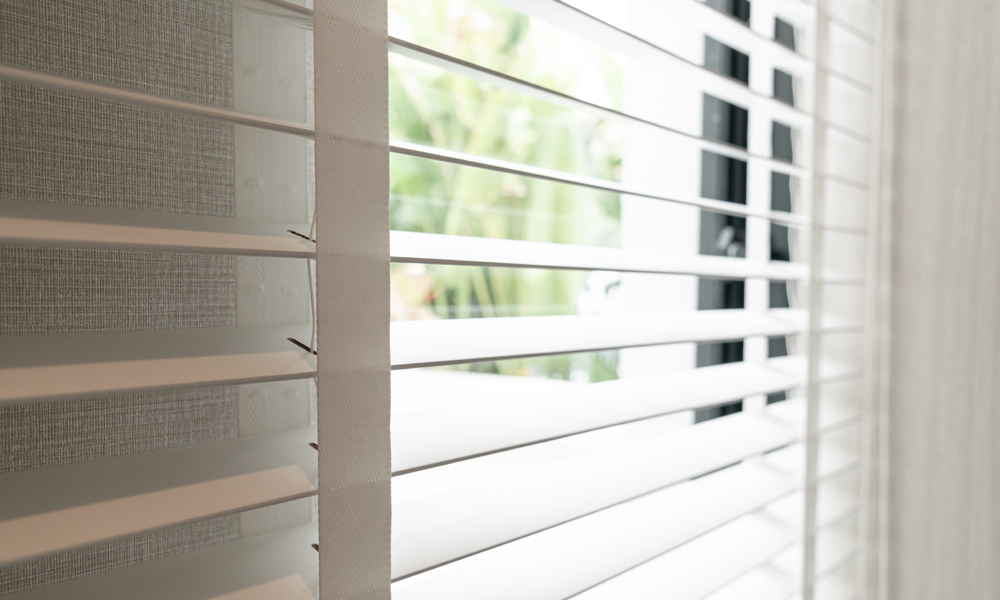
Have you ever wondered whether blinds should be lighter or darker than walls? It’s a great question and one that should be considered when approaching an optimal interior blind solution for your home or business renovation.
Unfortunately, this is not a “Yes” “No” answer – there’s more to it than that! It depends on a few factors. What we will do here, (and hopefully this is useful for you) is look at some common colour-difference examples and also important considerations that have bearing on this question.
Blinds Same Colour as Walls
When your blinds are the same colour as your walls, you’re effectively creating a continuous look with your interior blind installation. The presence of the blinds is absolutely minimised, which means you have a totally safe solution, from the point of view of being concerned about design errors! The blinds, frames and walls work together, with no visual hierarchy. The advantage of this solution is that it’s safe and gives you total control over the design of the room with accessories, artwork & furniture, and that it’s easily transferrable to a new resident or style. The disadvantage is in the eye of the beholder – there are many design opportunities with interior blinds, and using the same colour as the walls doesn’t necessarily make the most of these opportunities.
Blinds Lighter than the Walls
When blinds are lighter than the walls, you have a degree of contrast in the room. Is this contrast better, or worse than the contrast created by blinds that are darker than the walls? One advantage of lightening the blinds is that you can also lighten the room. If the room is smaller, or darker, adding lighter blinds can help to lift and extend the perspective of the room. Also, a pattern on lighter blinds can reference the outdoors as well and integrate the blinds with the walls via the pattern.

Blinds Darker than the Walls
Opting for blinds that are slightly darker than the colour of the walls & frames gives the blinds more visual strength in the room. By defining the window shapes with our slightly darker colour, we convert them into design objects within the room.
These objects have a relationship with each other and also with the other elements inside the room. Depending on the room, these relationships can be optimised to anchor the overall design of the room and give direction and stability to the layout. Note how in the example below, the windows align with the edges of the desk creating an invisible grid within the room. The strength of this grid is aligned to the fact that the blinds have sufficient presence to create them – an advantage of slightly darker blinds than walls.
Blind vs Wall Ratio
Using a screen fabric roller blind (which during the daylight hours allows light transmission through the blinds, making them lighter than the walls) creates indoor / outdoor integration, and a spaciousness that extends beyond the room. Here, the blinds effectively become a whole wall unto themselves, an altogether different consideration than when blinds form only a part of a wall. The extent of then blinds vs the wall should always be taken into account when considering the lightness and darkness of blinds vs walls for this reason. In this example, the blinds become a feature wall that has a relationship with the rest of the room, which is a different proposition altogether.
Factoring Frames
In art, the frame plays an important role in the presentation of the artwork. When pictures are professionally framed, they are made in sympathy to the artwork they’re framing, and even the room for which they are intended. Frames matter, because they establish a relationship between the artwork and the room.
In the case of blinds, frames perform a similar role, but they’re not necessarily being changed when you change your blinds. So they need to be taken into account, particularly when they’re different to the walls. In this roller blind example below, the white frames are a lighter colour than the walls, and the blinds are darker than both. This has the effect of strengthening the presence of the blind, a handy result since the blind is only slightly darker than the wall. These are the little nuances that make interior designs interesting and successful.
Summary
In summary, there are advantages and disadvantages to different approaches. With interior blinds, it’s really important to achieve a result that has longevity (that you won’t get sick of quickly) and that contributes positively to the style of your room. This can be achieved with both dark and lighter window-dressing solutions.
